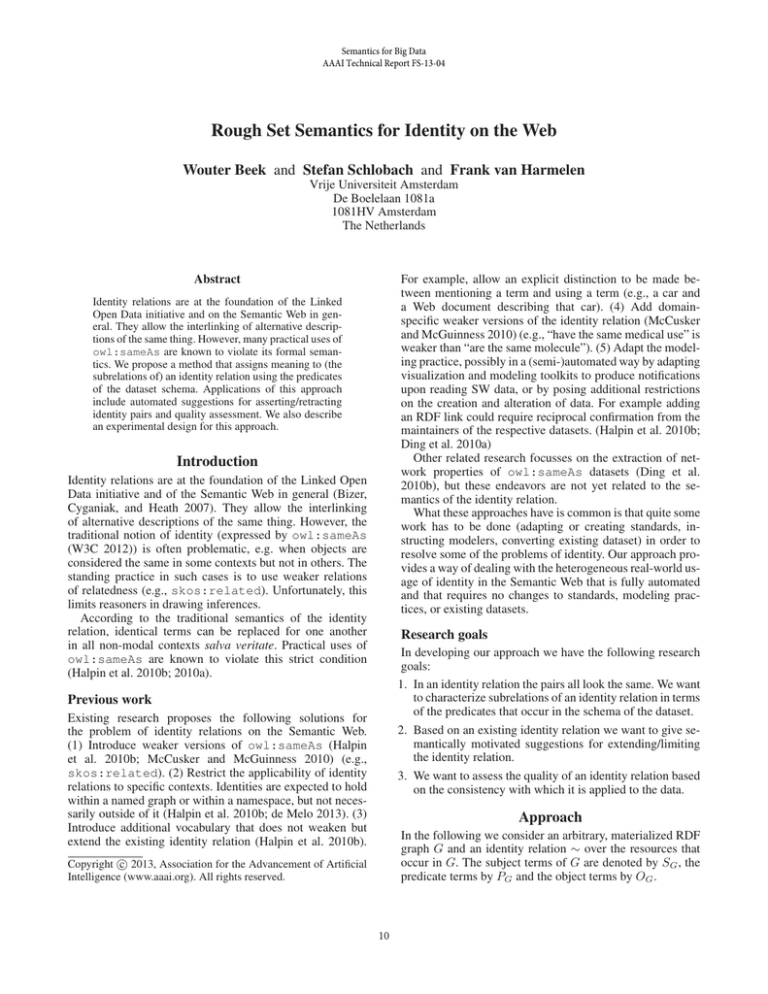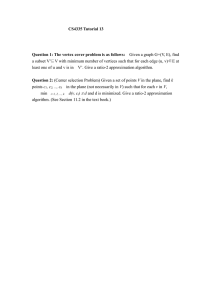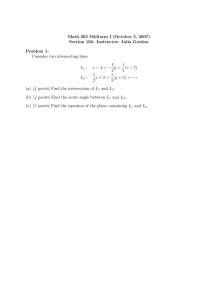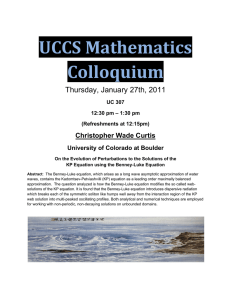
Semantics for Big Data
AAAI Technical Report FS-13-04
Rough Set Semantics for Identity on the Web
Wouter Beek and Stefan Schlobach and Frank van Harmelen
Vrije Universiteit Amsterdam
De Boelelaan 1081a
1081HV Amsterdam
The Netherlands
Abstract
For example, allow an explicit distinction to be made between mentioning a term and using a term (e.g., a car and
a Web document describing that car). (4) Add domainspecific weaker versions of the identity relation (McCusker
and McGuinness 2010) (e.g., “have the same medical use” is
weaker than “are the same molecule”). (5) Adapt the modeling practice, possibly in a (semi-)automated way by adapting
visualization and modeling toolkits to produce notifications
upon reading SW data, or by posing additional restrictions
on the creation and alteration of data. For example adding
an RDF link could require reciprocal confirmation from the
maintainers of the respective datasets. (Halpin et al. 2010b;
Ding et al. 2010a)
Other related research focusses on the extraction of network properties of owl:sameAs datasets (Ding et al.
2010b), but these endeavors are not yet related to the semantics of the identity relation.
What these approaches have is common is that quite some
work has to be done (adapting or creating standards, instructing modelers, converting existing dataset) in order to
resolve some of the problems of identity. Our approach provides a way of dealing with the heterogeneous real-world usage of identity in the Semantic Web that is fully automated
and that requires no changes to standards, modeling practices, or existing datasets.
Identity relations are at the foundation of the Linked
Open Data initiative and on the Semantic Web in general. They allow the interlinking of alternative descriptions of the same thing. However, many practical uses of
owl:sameAs are known to violate its formal semantics. We propose a method that assigns meaning to (the
subrelations of) an identity relation using the predicates
of the dataset schema. Applications of this approach
include automated suggestions for asserting/retracting
identity pairs and quality assessment. We also describe
an experimental design for this approach.
Introduction
Identity relations are at the foundation of the Linked Open
Data initiative and of the Semantic Web in general (Bizer,
Cyganiak, and Heath 2007). They allow the interlinking
of alternative descriptions of the same thing. However, the
traditional notion of identity (expressed by owl:sameAs
(W3C 2012)) is often problematic, e.g. when objects are
considered the same in some contexts but not in others. The
standing practice in such cases is to use weaker relations
of relatedness (e.g., skos:related). Unfortunately, this
limits reasoners in drawing inferences.
According to the traditional semantics of the identity
relation, identical terms can be replaced for one another
in all non-modal contexts salva veritate. Practical uses of
owl:sameAs are known to violate this strict condition
(Halpin et al. 2010b; 2010a).
Research goals
In developing our approach we have the following research
goals:
1. In an identity relation the pairs all look the same. We want
to characterize subrelations of an identity relation in terms
of the predicates that occur in the schema of the dataset.
2. Based on an existing identity relation we want to give semantically motivated suggestions for extending/limiting
the identity relation.
3. We want to assess the quality of an identity relation based
on the consistency with which it is applied to the data.
Previous work
Existing research proposes the following solutions for
the problem of identity relations on the Semantic Web.
(1) Introduce weaker versions of owl:sameAs (Halpin
et al. 2010b; McCusker and McGuinness 2010) (e.g.,
skos:related). (2) Restrict the applicability of identity
relations to specific contexts. Identities are expected to hold
within a named graph or within a namespace, but not necessarily outside of it (Halpin et al. 2010b; de Melo 2013). (3)
Introduce additional vocabulary that does not weaken but
extend the existing identity relation (Halpin et al. 2010b).
Approach
In the following we consider an arbitrary, materialized RDF
graph G and an identity relation ∼ over the resources that
occur in G. The subject terms of G are denoted by SG , the
predicate terms by PG and the object terms by OG .
c 2013, Association for the Advancement of Artificial
Copyright Intelligence (www.aaai.org). All rights reserved.
10
the same properties denoted by those ppms (def. 2).1 We say
that two resource pairs are indiscernible in case both pairs
are indiscernible for the same P ∗ ⊆ P(PGn ) (def. 3).2
For illustrative purposes we use the IIMB dataset that is
used in the instance matching track of the 2012 Ontology
Alignment Evaluation Initiative (OAEI) (OAEI 2012). This
dataset consists of eighty ontologies Gi (for 1 ≤ i ≤ 80)
that are linked to a single base ontology G0 . A graph G is
the result of fully materializing the graph merge of Gi (for
some 1 ≤ i ≤ 80) and G0 . For each of these eighty linked
ontologies a reference mapping is available.
In RDF a property consists of a single predicate term (e.g.,
the property “is spoken in” is denoted by predicate term
IIMBTBOX:spoken_in in the IIMB dataset). We generalize the notion of a property to consist of an arbitrary number of predicate terms. For this we define a depth-n predicate
path map (abbr. ppm) that is characterized by a sequence of
n predicates and denotes a (functional) mapping from subject terms into sets of object terms (def. 1, where pi ∈ PG
and [p]∼ is the identity set for p).
Definition 2 (Indiscernibility).
i=0
p∈[pi+1 ]∼
(2)
2 2
IND(P ∗ ) = {hhx1 , y1 i, hx2 , y2 ii ∈ (SG
) |
∀P ∈P ∗ hx1 , y1 i ∈ IND(P ) ↔ hx2 , y2 i ∈ IND(P )}
(3)
As explained above, for a given set of identity pairs there
may be multiple pairs that have the same shared properties.
These sets of predicates that are shared across resource pairs
are considered to give a description of a specific subrelation
of the identity relation.
According to the standard definition, identical resources
are indiscernible with respect to all properties. We take a
given set of identity pairs and partition it into subsets which
we can describe as being cl∼ (P )-indiscernible, for P ⊆ PGn .
Fig. 1 shows an example of a discernibility partitioning
for a given identity relation.
Definition 1 (Predicate path map (ppm)).
fhp1 ,...,pn i (s) = o ∈ OG ∃x1 ,...,xn−1
^n−1
[
hI(xi ), I(xi−1 )i ∈
2
IND(P ) = {hx, yi ∈ SG
| ∀p∈cl∼ (P ) fp (x) ≈ fp (y)}
(1)
Ext(I(p))
Approximation
In the previous section we partitioned a given identity relation ∼ into subrelations that can be distinguished in terms
of schema predicates (or n-depth paths of those predicates).
In this section we create an approximation of the identity
relation. This approximation will allow us to (1) give suggestions about which pairs to in/exclude from the identity
relation, and (2) give an indicator for the quality of the identity relation.
For the approximation of the identity relation we use
rough set theory (Pawlak 1991) to represent an approximation of a given identity relation ∼. The domain for our rough
set approach is the Cartesian product of SG . The set of predicates is the powerset of PG .
For an arbitrary binary relation ∼ we can define a higher
(def. 4) and a lower (def. 5) approximation of that relation.
In definitions 4 and 5, R characterizes a similarity relation
between resource pairs. The intuition behind these definitions is that non-∼-pairs that are similar to ∼-pairs should
be in the higher approximation, whereas no ∼-pair that has
a similar non-∼-pair should be in the lower approximation.
Examples of properties characterized by predicate path maps
are “is spoken in” (depth-1) and “is spoken in a country
whose form of government is” (depth-2).
Shared properties and indiscernibility
When we look at the triples that constitute a set of identity
relations, we see that all links look the same. But when we
take the triples in which the subject and object terms occur
into account, we see that within the identity relation there
may be different subrelations that we can identify in terms
of the predicates that occur in the schema.
For instance, in the IIMB dataset there are
some identical resources that share the property
IIMBTBOX:spoken_in, while other pairs share the
property IIMBTBOX:form_of_government. The set
of pairs of resources that are spoken in the same language
may even be disjoint from the set of pairs of resources that
have the same form of government.
Note that we are not only interested in the properties that
resources share with one other (e.g., where they are spoken,
or which form of government they have), but we are also interested in resource pairs that share the same sharing properties. We can thus identify subsets of an identity relation
based on differences in the sets of predicate path maps relative to which they take resources to be indiscernible from
one another.
In the example above, one subset of the identity relation
does not discern resources that are spoken in the same language, whereas another subset of the identity relation does
not discern resources that have the same form of government.
We say that two resources are indiscernible with respect
to a set of predicate path maps P ⊂ PGn in case they share
Definition 3 (Higher & lower approximation).
x∼y ⇐⇒
x∼y ⇐⇒
∃u, v(hu, viRhx, yi ∧ u ∼ v)
∀u, v(hu, viRhx, yi → u ∼ v)
(4)
(5)
Since we want to stay close to the traditional notion of
identity, defined in terms of indiscernibility, we choose
IND(P(PGn )) as our similarity relation.
Figure 1 shows an example of the lower and higher approximations for a linkset. Since in this figure a partition is
1
P must be closed under the identity relation, i.e.,
[
cl∼ (P ) =
([p1 ]∼ × . . . × [pn ]∼ )
hp1 ,...,pn i∈P
2
In order to assertain that fp (x) and fp (y) denote the same set
of resources, identity does not suffice. ≈ gives a special treatment
for blank nodes and typed literals (skipped here for brevity).
11
0.02% {rdf:type} 40
44% {iimb:article,rdf:type} 162
100% {iimb:article,iimb:date_of_birth,rdf:type} 2
2% {iimb:name,rdf:type} 4
50% {iimb:article,iimb:iso_639,rdf:type} 1
0.3% {iimb:spoken_in,rdf:type} 1
99% {iimb:article,iimb:name,rdf:type} 153
100% {iimb:article,iimb:dialect,iimb:iso_639,rdf:type} 1
100% {iimb:article,iimb:form_of_government,iimb:has_capital,iimb:name,rdf:type} 1
Accuracy: 4.383989e-06
Figure 1: An example of a discernibility partition for an identity relation consisting of 365 pairs applied to the fourth IIMB
linkset. Each node is annotated with the set of predicates P for which its pairs are P -indiscernible. The number of identity pairs
within each partition set is displayed to the right of the predicate set label. Partition sets that contain no identity pair are not
show. The number that occurs to the left of the predicate label in each node indicates how may pairs in that node are identity
pairs. The lower approximation consists of the nodes with a solid border, indicating that they contain only identity pairs. The
higher approximation consists of all displayed nodes.
only drawn when there is at least one identity pair that is indiscernible with respect to some set of predicates, the higher
approximation amounts to the entire figure. The lower approximation only consists of those partition sets that contain
at least one identity pair, and that contain no non-identity
pair.
Definition 4 (Discernible model).
A domain SG is fully discernible w.r.t. a binary relation ∼ iff
∀x, y ∈ SG ([x]∼ = [y]∼ ∨ P([x]∼ ) 6= P([y]∼ ))
(7)
From this definition it is clear that a domain of discourse is
fully discernable just in case there exists a binary relation ∼
such that α(∼) = 1.0.
Quality
Experimental design
Given the rough set representation h∼, ∼i of identity relation ∼, we can calculate the accuracy of this approximation
with equation 6.
α(∼) = |∼|/|∼|
In section we enumerated three research goals. The first goal
is met, since an indiscernibility partition characterizes subrelations based on the ppms P for which the pairs in that sets
are cl∼ (P )-indiscernible. In this way we can distinguish between different types of identity by treating P as a description of a (sub)set of identity pairs.
The second goal is met, since the notion of a rough set
allows us to distinguish between pairs that must be (lower
approximation) and those that may be (i.e., “not must not”,
higher approximation) in the identity relation. If we want
to add/remove pairs of the identity relation, we should not
consider pairs of the former but only pairs of the latter kind.
The third goal is met, since the measure for rough set accuracy is based on the discernibility criteria of an identity
set. The crispness of the set is proportional to the quality of
the identity relation, based on its semantic consistency.
Our approach provides a new experimental design for
evaluating hypothesis regarding identity relations that have
not been evaluated before in terms of the semantics of the
data.
(6)
The intuition behind the usefulness of equation 6 is that
the crispness of a set should be proportional to the quality
of the identity relation on which it is based. Since a consistently applied identity relation has relatively many partition
sets that contain either no identity pairs (small value for ∼)
or only identity pairs (big value for ∼), a more consistent
identity relation has a higher accuracy.
Now that we have a formal metric for identity relation
quality, we can define the characteristics of an ideal identity
relation. Traditionally the ideal identity relation ensures indiscernibility for all expressible properties in the language
(the principle of the indiscernibility of identicals). According to this traditional view an identity relation becomes of
higher quality by considering more predicates (or ppms) according to which two resources are not allowed to be discernible. We give a different quality criterion.
We observe that for a given equivalence relation ∼ defined
over a domain of resources SG we can define the notion of
full discernibility:
Hypotheses
Using this new approach the following hypothesis can be
validated:
12
paper apply to owl:sameAs relations in the same way
in which they apply to any other binary relation (e.g.,
skos:related).
We are currently in the process of validating the above
enumerated hypotheses. The results of these evaluations are
continuously being published on wouterbeek.com/identityon-the-web. The website currently contains the automated
results of all eighty IIMB alignments, drawn from the
instance matching track of the OAEI 2012. The website also refers to the publicly available Git repository
github.com/wouterbeek/IOTW where the implementation
discussed in section can be found.
1. Take an owl:sameAs relation and a skos:related
relation defined over the same domain. Merge them into a
new binary relation ∼. Establishing the lower and higher
approximation of ∼, the hypothesis is that pairs from
owl:sameAs occur more frequently in the lower boundary than pairs from skos:related.
2. Take a set of alignment pairs, each of which is associated
with a confidence measure between 0.0 and 1.0. Choose
an arbitrary cutoff point 0.0 < c < 1.0. The hypothesis
is that alignments with a confidence larger than c occur
more frequently in the lower approximation than alignments with a confidence smaller than c.
3. Take a set of automatically generated alignment pairs with
associated confidence measures and take the gold standard or reference alignment for the same dataset. The hypothesis is that pairs that occur in the lower approximation
of the alignment appear relatively more often in the gold
standard than pairs that occur in the higher approximation
of the alignment.
4. The accuracy measure α of a reference alignment is generally higher than the accuracy measure of an automatically generated alignment for the same dataset. Or, the
accuracy measure is generally higher for identity relations
that are considered correct by domain experts.
References
Bizer, C.; Cyganiak, R.; and Heath, T. 2007. How to publish
linked data on the web. Last accessed in May 2013.
de Melo, G. 2013. Not quite the same: Identity constraints
for the web of linked data. In Proceedings of the American
Association for Artificial Intelligence 2013.
Ding, L.; Shinavier, J.; Finin, T.; and McGuinness, D. L.
2010a. Owl: sameas and linked data: an empirical study.
Ding, L.; Shinavier, J.; Shangguan, Z.; and McGuinness, D.
2010b. Sameas networks and beyond: Analyzing deployment status and implications of owl:sameas in linked data.
In Patel-Schneider, P.; Pan, Y.; Hitzler, P.; Mika, P.; Zhang,
L.; Pan, J.; Horrocks, I.; and Glimm, B., eds., The Semantic
Web ISWC 2010, volume 6496 of Lecture Notes in Computer Science. Springer Berlin Heidelberg. 145–160.
Halpin, H.; Hayes, P.; McCusker, J.; McGuinness, D.; and
Thompson, H. 2010a. When owl:sameAs Isn’t the Same:
An Analysis of Identity in Linked Data. Lecture Notes in
Computer Science. Springer Berlin / Heidelberg. 305–320.
Halpin, H.; Hayes, P.; McCusker, J.; McGuinness, D.; and
Thompson, H. 2010b. When owl:sameas isnt the same: An
analysis of identity in linked data. In Patel-Schneider, P. F.;
Pan, Y.; Hitzler, P.; Mika, P.; Zhang, L.; Pan, J. Z.; Horrocks,
I.; and Glimm, B., eds., The Semantic Web ISWC 2010, volume 6496 of Lecture Notes in Computer Science. Springer
Berlin Heidelberg. 305–320.
McCusker, J., and McGuinness, D. 2010. Towards identity
in linked data. Proceedings of OWL Experiences and Directions Seventh Annual Workshop.
OAEI. 2012. The instance matching track of the ontology
alignment evaluation initative (oaei) 2012.
Pawlak, Z. 1991. Rough Sets: Theoretical Aspects of Reasoning About Data. Kluwer Academic Publishing Dordrecht.
Schreiber, G.; Amin, A.; van Assem, M.; de Boer, V.;
Hardman, L.; Hildebrand, M.; Hollink, L.; Huang, Z.; van
Kersen, J.; de Niet, M.; Omelayenko, B.; van Ossenbruggen,
J.; Siebes, R.; Taekema, J.; Wielemaker, J.; and Wielinga, B.
2006. Multimedian e-culture demonstrator. The Semnantic
Web - ISWC 2006, Athens, Georgia 4273:951–958. Winner
of the Semantic Web Challenge 2006.
W3C. 2012. Owl 2 web ontology language direct semantics
(second edition).
Implementation
The implementation built for this paper is deployed as an
extension pack of the ClioPatria triple store (Schreiber et al.
2006). For RDF graphs that are loaded in ClioPatria this extension calculates the discernibility partition, rough set approximation and accuracy. The results are visualized using
GraphViz and are displayed in a Web interface using SVG.
Interactive Ajax code allows the user to click on nodes in the
SVG graphic to navigate to descriptions of the resource pairs
that occur in that partition set while not being in the identity
relation. This implementation may facilitate the validation
of hypotheses in this new experimental setup.
Conclusion
In this paper we have given an new approach for characterizing, extending/retracting, and assessing identity relations.
Our approach does this in purely qualitative terms, using
schema semantics. In contemporary ontology alignment and
data linking activities nonsemantic aspects of resources play
a role as well. For instance similarity assessment for natural
language labels is often used in data linking.
We think that the qualitative means of characterizing an
identity relation are a useful addition to existing quantitative
means. Also, we think that it is more useful and viable to
enrich existing identity relations in the LOD based on the
semantics of the datasets in which they occur, than to introduce new relationships into SW languages. Apart from the
practical difficulties of teaching practitioners and transforming/enriching existing datasets, we suggest that the meaning
of an identity (sub)relation is partially defined in its use, i.e.,
in the indiscernibility criteria it embodies.
For our approach it is not necessary to pose additional
restrictions on a binary relation ∼. The definitions in this
13




